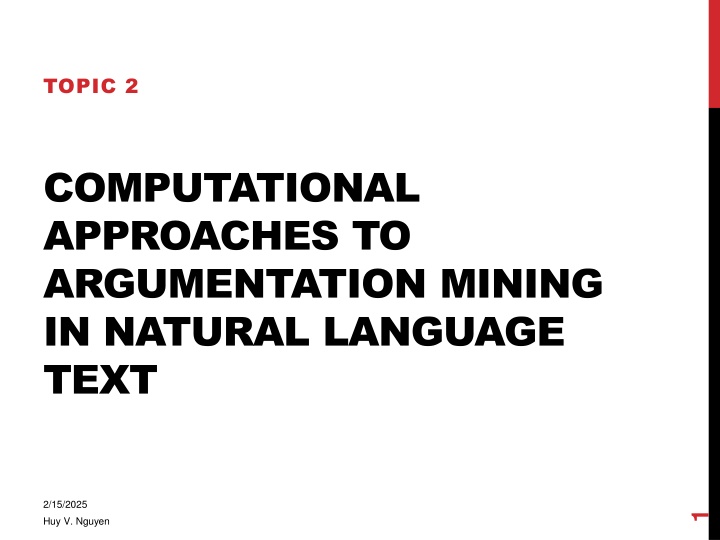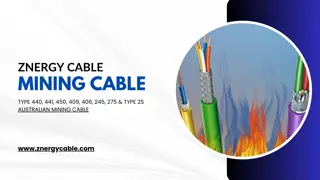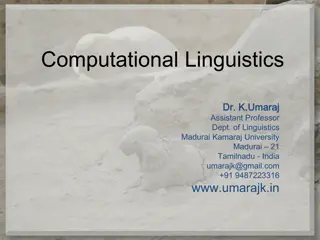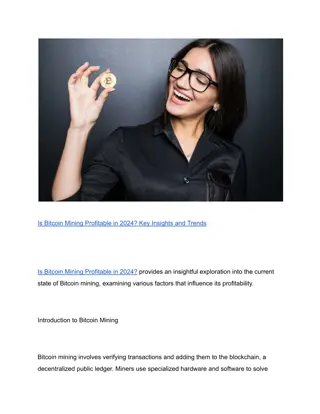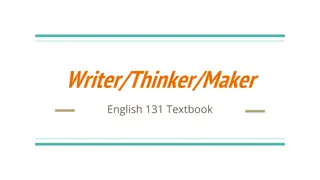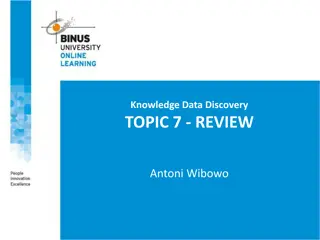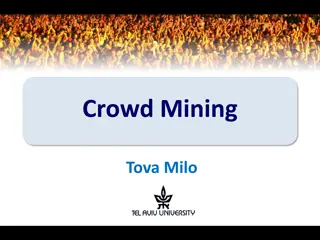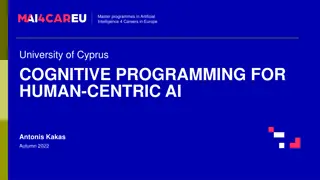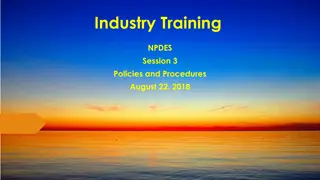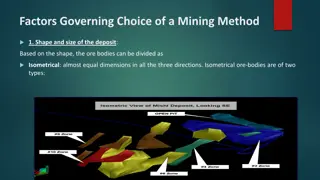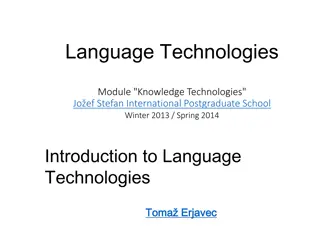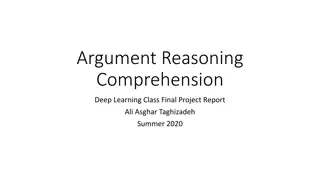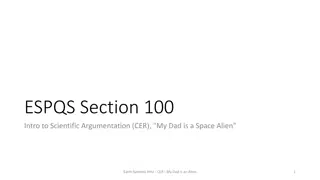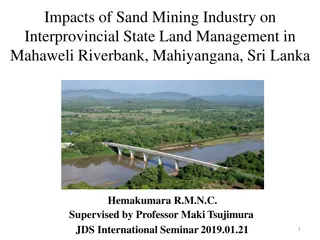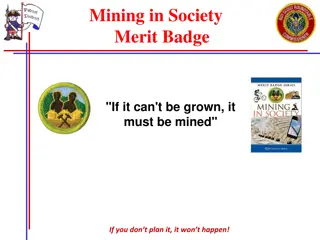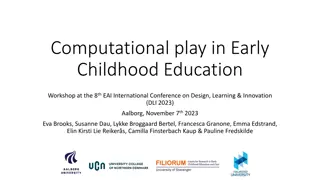Computational Approaches to Argumentation Mining in Natural Language
This presentation delves into the process of argumentation, argument structures, annotation issues, computational models, and applications in AI systems. Explore the intersection of argumentation and discourse in natural language text mining.
Download Presentation

Please find below an Image/Link to download the presentation.
The content on the website is provided AS IS for your information and personal use only. It may not be sold, licensed, or shared on other websites without obtaining consent from the author.If you encounter any issues during the download, it is possible that the publisher has removed the file from their server.
You are allowed to download the files provided on this website for personal or commercial use, subject to the condition that they are used lawfully. All files are the property of their respective owners.
The content on the website is provided AS IS for your information and personal use only. It may not be sold, licensed, or shared on other websites without obtaining consent from the author.
E N D
Presentation Transcript
TOPIC 2 COMPUTATIONAL APPROACHES TO ARGUMENTATION MINING IN NATURAL LANGUAGE TEXT 2/15/2025 1 Huy V. Nguyen
OUTLINE Introduction to argumentation Argumentation mining the problem Argumentation v. discourse Annotation and corpora Annotator issue Computational models Applications of argumentation in AI systems 2/15/2025 2 Huy V. Nguyen
INTRODUCTION TO ARGUMENTATION Process of forming reasons, justifying beliefs and drawing conclusions with the aim of influencing the thoughts and actions of others (Mochales Palau & Moens 2009) Acceptability of statements Validity of structures More operational: process whereby arguments are constructed, exchanged and evaluated in light of their interaction with other arguments Arguments as building blocks 2/15/2025 3 Huy V. Nguyen
ARGUMENT & ARGUMENTATION SCHEME Argument: elementary unit of an argumentation Formed by premises and a conclusion Premises and conclusion can be implicit (i.e. enthymemes) Sentence level or smaller text spans? Argumentation scheme: reasoning pattern Structures of templates for forms of argument Along with critical questions to evaluated argument Offers one way of processing any real world argument 2/15/2025 4 Huy V. Nguyen
SCHEME EXAMPLES (Feng & Hirst 2011) If we stop the free creation of art, we will stop the free viewing of art. 2/15/2025 5 Huy V. Nguyen
ARGUMENTATION IN NATURAL LANGUAGE TEXT Argumentation based on informal logic Natural language arguments Reviews Scientific articles Legal documents Political debates 2/15/2025 6 Huy V. Nguyen
THE PROBLEM Mining a document (collection) for arguments Relations between arguments (argumentation structures) Internal structure of each individual arguments (schemes) New research area In correspondence with information retrieval, information extraction, opinion mining Proposed applications Improve information retrieval/extraction Natural extension to opinion mining Public deliberation 2/15/2025 7 Huy V. Nguyen
MORE APPLICATIONS (Call for papers, First Workshop on Argumentation Mining, ACL 2014) Instructional context Mines written and diagrammed arguments of students for purposes of assessment and instruction Importance Computer-supported peer reviews Automated essay assessment Large-scale online courses/MOOCs 2/15/2025 8 Huy V. Nguyen
ARGUMENTATION V. DISCOURSE Argumentation structures are based on discourse structures Discourse for coherence but argument for acceptability Peen Discourse Treebank (PDTB) Discourse relation between two text spans (mostly adjacent) Exhibits connection between discourse relations and argumentation schemes (Cabrio et al. 2013) E.g. Scheme <Argument from Cause to Effect> = PDTB relation <CONTINGENCY:cause> 2/15/2025 9 Huy V. Nguyen
ARGUMENTATION V. DISCOURSE (2) Rhetorical Structure Theory (RST) Underlying intentions of the speaker or writer Adequate framework for representing argumentation structure (Peldszus & Stede 2013) 10 2/15/2025 Huy V. Nguyen
ANNOTATION AND CORPORA Not too many results reported Lack of data (Peldszus & Stede 2013) Annotated data of arguments/schemes AraucariaDB argument corpus European Court of Human Rights (ECHR) Limited in terms of size and domain Not really about argumentation Scientific articles (writing structure convention): argumentative zones, core science concepts Discourse Treebank: PDTB and RST More available but how to support argumentation mining? 2/15/2025 11 Huy V. Nguyen
ARAUCARIADB Argumentative examples of diverse sources and different regions (Reed et al. 2008) Argument consists of argument units (AU) Conclusion followed by optional premises Identified with argumentation scheme 2/15/2025 12 Huy V. Nguyen
ARGUMENTATIVE ZONES Rhetorical-level analysis of scientific articles (Teufel et al. 1999, Teufel & Moens 2002) Rhetorical status of single, important sentences w.r.t the communicative function of the whole paper 7 argumentative zone types A zones is formed of adjacent sentences of the same status Variants AZ-II, Core Science Concepts (CoreSC) (Liakata et al. 2010) Do not lay in argumentation theory Mines the role of each proposition towards the overall goal of the author (v. role of propositions towards the others) Role-sequence patterns can reveal argumentation strategy 2/15/2025 13 Huy V. Nguyen
AZ SNAPSHOTS 7 zone types Background (yellow) Other (orange) Own (blue) Aim (pink) Textual (red) Contrast (green) Basic (purple) 14 2/15/2025 Huy V. Nguyen
DISCOURSE CORPORA Discourse relation has been used for essay grading Signs of coherent writing (thesis, evidence) Far from signs of correct writing (validity and acceptability of statements) Peen Discourse Treebank (Prasad et al. 2008) Closely related to argumentation schemes (Cabrio et al. 2013) Good indicators for argument extraction, as the first step towards argument validation RST Discourse Treebank (Carlson et al. 2003) Explain well the overall argumentation structure (Peldszus & Stede 2013) To mine argumentation patterns/strategies 2/15/2025 15 Huy V. Nguyen
OPINION AND ARGUMENTATION Annotated corpus of news editorials (Bal & Saint-Dizier 2010) Argumentation = claim + justification Argumentation Argument types, rhetoric relations Opinion Orientation, support/oppose Persuasion Direct strength, relative strength The first (only) available corpus for mining impact of argumentation and opinion in persuasion 2/15/2025 16 Huy V. Nguyen
ANNOTATOR ISSUE Annotation task (Peldszus & Stede 2013b) Identify central claim, choose dialectical role for other text segment, determine argumentative function of each segment 26 students with minimal training (~35 min.) Show moderate agreement Annotator ranking and clustering for identifying reliable subgroups Achieve good agreement Opens a direction for more effective annotation Using minimal expert-generated labels to rank non-expert annotators Less training effort 2/15/2025 17 Huy V. Nguyen
COMPUTATIONAL MODELS Argument detection (Moens et al. 2007, Mochales Palau & Moens 2009, Araucaria and ECHR corpora) Classifies (legal) text sentences: argumentative v. not Linguistic features: ngrams, POS, parse, keywords Argument classification (Feng & Hirst 2011, Araucaria corpus) Classifies arguments regarding schemes (argument components available) Identifying coherence relation (Madnani et al. 2012, student writing) First step towards argument parsing Classifies content language v. shell language based on rules E.g. There is a possibility that they were a third kind of bear apart from black and grizzly bears. 2/15/2025 18 Huy V. Nguyen
COMPUTATIONAL MODELS (2) Classifying segment status (Teufel & Moens 2002, Guo et al. 2010) Sentence classification regarding scientific text discourse Semi-automated argumentative analysis (Wyner et al. 2012) Discourse indicators, sentiment lexicon, domain lexicon Helps instantiate Consumer Argumentation Scheme (CAS) Online debates Debate-side classification: mines opinion + target (Somasundaran & Wiebe 2009) Debate argument acceptability using textual entailment + abstract argumentation theory (Cabrio & Villata 2012) 19 2/15/2025 Huy V. Nguyen
GOOD & BAD ABOUT MODELS First steps towards argumentation mining Different in terms of tasks, data, granularities Tasks seem to supplement each other but the data says no Legal text, scientific articles, student writing Strict experimental settings make models less practical Argument components available, scientific discourse Application is still limited (if not possible) 20 2/15/2025 Huy V. Nguyen
TOOLS & APPLICATIONS Carneades (Gordon & Walton 2006) Argumentation Framework to determine the defensibility of arguments, and acceptability of statements RST parser (Feng & Hirst 2012) PDTB parser (Lin et al. 2014) Automated essay assessment (Burstein et al. 2002) Recommendation (Chesnevar et al. 2009) Spoken dialogue system (Andrews et al. 2008, Riley et al. 2012) Automated persuasion Still discourse relations or abstract argumentation 2/15/2025 21 Huy V. Nguyen
CONCLUSIONS The available Formal argumentation proving systems Annotated data Discourse parsers The TODO s Better exploit discourse relations to work on free-text (student writing, news articles) Go beyond legal documents and scientific articles Get along with opinion mining Need more attention from NLP community 2/15/2025 22 Huy V. Nguyen
